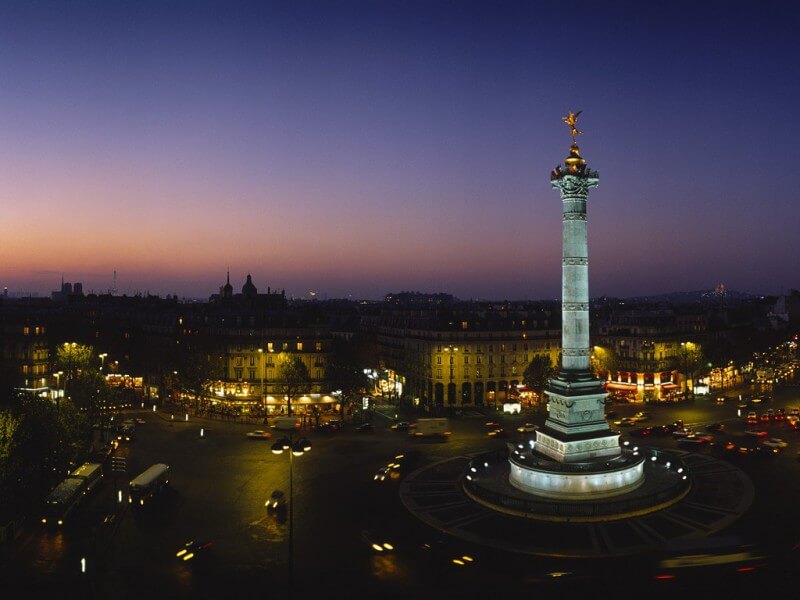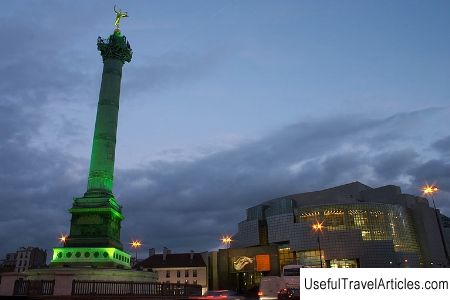On the places and events of the Great French Revolution
Rating: 9,2/10 (9544 votes)   Paris Great The French Revolution is a major transformation of the political and social system of France, which began in 1789 and by 1792 led to the collapse of the country of the monarchy. This important political event, which took place mainly in Paris, left behind a number of monuments that will be of interest to all history buffs. Despite the fact that many of them are now destroyed and look completely different, they are still worth visiting for anyone interested in the history of the world in general and France in particular. BastilleBastille is practically a symbol of the French Revolution, after all, it was with its assault on July 14, 1789 that this grandiose historical event began. In those days, the Bastille was a prison where criminals, including political ones, were kept, and its destruction was, as it were, a symbol of the destruction of the monarchical system. Some time after the capture, the Bastille was dismantled by throwing its stones on the Bridge of Concord. So today, instead of the famous prison, you can only admire the Place de la Bastille, unfortunately, constantly filled with cars and built up with very eclectic buildings that do not in any way remind of the revolutionary past. From the Bastille itself, there is only a reminder of the foundation - its silhouette drawn on the paving stone - and the plan of the fortress drawn on one of the houses. Every year on July 14, dances and various entertainment in honor of the holiday are held here on the square.  Place de la Bastille ConciergerieConciergerie is a real old palace, as if copied from chivalrous novels. It is one of the few monuments of the French Revolution that have survived to this day. Since 1793, the Conciergerie has become a prison for political criminals from the point of view of revolutionaries. He quickly gained fame as one of the harshest prisons in France. For two revolutionary years almost three thousand people managed to wait for their death sentence here. Maximilian Robespierre, Queen Marie Antoinette, poet Andre-Marie-Chenier, spy and dancer Mata Hari and many other famous personalities spent their last days in this prison. The palace was reconstructed in the 19th century. Around the same time, the prison was closed, and the Conciergerie became a historical monument, which it remains to this day.  Concierges Champ de MarsChamp de Mars is one of the main sights of Paris, because it is on it that the most famous monument in France - the Eiffel Tower is located. However, the Champ de Mars played a role in the French Revolution. Here in 1790 the first anniversary of the taking of the Bastille was held, that is, the first holiday of the Revolution. A year later, on July 17, 1791, in the square, the guards shot 50 unarmed people who demanded the overthrow of the king. Then for many years it was on the Champ de Mars that people gathered who wanted to fight for the Republic.  Champ de Mars TempleThe Temple is an ancient medieval fortress located on territory II and III modern districts. Now on the site of this fortress there is a metro station and a square. After the Great French Revolution, the Temple became a new Bastille, but for the monarchists. King Louis XVI, Queen Marie Antoinette before being sent to the Conciergerie, Madame Elizabeth, Louis XVII, Princess Maria Teresa, as well as followers of the monarchy were kept here. During the reign of Napoleon, the emperor ordered to destroy the castle, as it was a symbol of the collapse of the monarchy. After that, the castle was not restored. TuileriesThe Tuileries is the palace of kings, located in the center of Paris and since the time of Louis XVI served as the main residence of monarchs. The palace was burned down at the Paris Commune in 1871 and was never restored, so now only a park and two pavilions (Marsanne and Flora) remain in its place, which are part of the Louvre ensemble, with which the Tuileries Palace once formed a single whole. This palace played a very important role in the French Revolution. First, in 1789, Louis XVI and his wife fled here from Versailles. After their unsuccessful attempt to escape, the palace went to the revolutionaries. It was in it that the various bodies of the First Republic sat until they moved to the Bourbon Palace. In 1792, the trial of Louis XVI took place in Tuileries. It was here that he was sentenced to death - out of 721 people, 361 MPs voted for his death.  Tuileries Place de la ConcordePlace de la Concorde is one of the main squares in Paris , characterized by outstanding architecture of the classicism era. During the French Revolution, the statue of the king that stood here was replaced with a giant guillotine. Louis XVI himself, Marie-Antoinette, Robespierre, Danton and many other people accused of actions against the revolution were executed in the square, at that time called the Plaza of the Revolution.  Concord Square ValmyValmy is one of the few places associated with the French Revolution that is located outside of Paris. Valmy is located in Champagne, and became famous for the battle that took place here between the revolutionary French and the Prussian troops of the First Coalition. The battle of Valmy took place on September 20, 1792. The battle turned out to be very ambiguous, since it practically did not lead to anything. However, it is considered to be very important, since it proved the viability of the French Revolution. Today, one landmark of those times has survived in Valmy - one of the two mills around which the main battle took place.  Valmy Mill The battle turned out to be very ambiguous, since it practically did not lead to anything. However, it is considered to be very important, since it proved the viability of the French Revolution. Today, one landmark of those times has survived in Valmy - one of the two mills around which the main battle took place.  We also recommend reading Cathedral of St. right. Simeon the God-Receiver and Anna the Prophetess (Sveta Simeona un Svetas Annas pareizticigo katedrale) description and photo - Latvia: Jelgava Topic: On the places and events of the Great French Revolution. |




